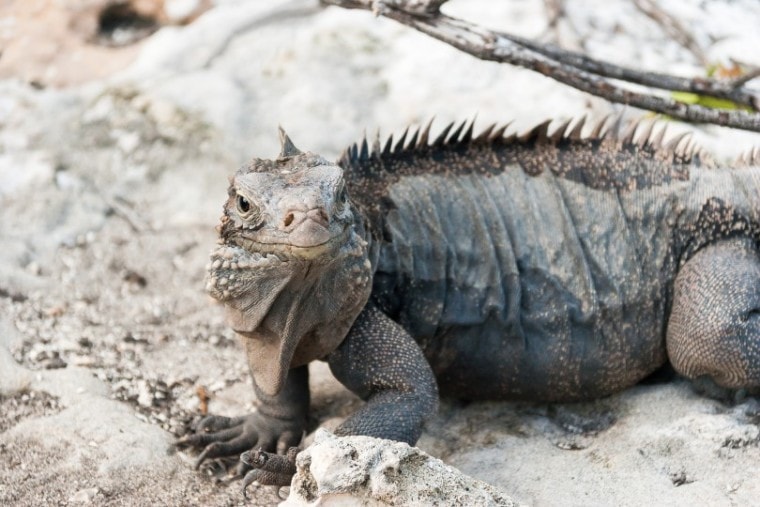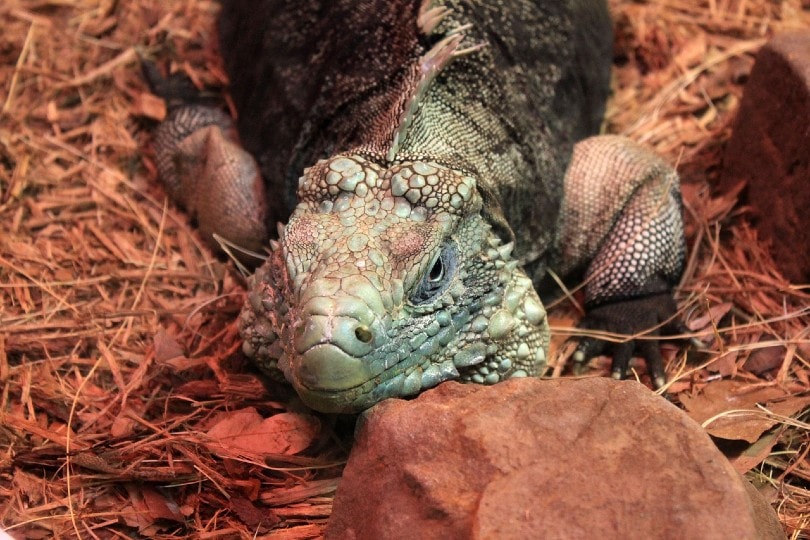
Cuban Rock Iguanas are a large species of iguana originating in the Caribbean. These iguanas are favorite pets among reptile lovers because they are relatively docile and easy to tame compared to other species. However, they are not necessarily low-maintenance pets, as they require specific living conditions and need to eat a large volume of food. If you’re interested in buying one of these iguanas, keep reading our guide to find out whether they are a good fit for you and your home.
Quick Facts about Cuban Rock Iguanas
| Species Name: | Cyclura nubila |
| Family: | Iguanidae |
| Care Level: | High |
| Temperature: | Basking at 120° F; remaining enclosure between 75-85° F; 40 – 80% humidity |
| Temperament: | Docile, easy to tame |
| Color Form: | Dark gray, red, dark green |
| Lifespan: | 60 – 70 years |
| Size: | 4’ – 7″ long; up to 15 pounds |
| Diet: | Omnivores—flowers, insects, snails, leaves, and fruits are staples |
| Minimum Enclosure Size: | Minimum size of 8’ x 4’ x 6’ (or a 40 – 55 gallon tank) |
| Enclosure Set-Up: | Several heat lamps required to achieve high temperatures needed for basking site; substrate of sand or soil at least 6” deep |
| Compatibility: | Compatible with other Cuban Rock Iguana if not two males |
Cuban Rock Iguana Overview
The Cuban Rock Iguana is one of nine species in the Cyclura genus. All nine species are considered to be endangered or vulnerable species, although conservation programs have helped to increase the population of Cuban Rock Iguanas. The Rhino Iguana and the Cuban Rock Iguana are the two most commonly bred Cyclura species bred in captivity. It is not known precisely how many Cuban Rock Iguanas exist in the wild, but it is estimated that that number is around 40,000 individuals. In addition to the population of Cuban Rock Iguanas in Cuba, feral populations of these lizards can be found in Puerto Rico and the Cayman Islands.
Growing to 4-7 feet long, the Cuban Rock Iguana is one of the largest lizards from its region of the world. Although they are docile pets, the size of the Cuban Rock Iguana can pose challenges for those with limited space.
How Much Do Cuban Rock Iguanas Cost?
If you are interested in buying a Cuban Rock Iguana, it will cost you between $300-$700, with the average cost being around $500-$600. Beyond the initial cost of purchasing one of these iguanas, you should also consider the costs associated with housing your pet. These animals can get very big and a standard tank is not adequate. Finally, you should consider the costs of caring for your Cuban Rock Iguana over a long period of time. Since these animals can live to be 60-70 years old, your iguana is likely a lifelong investment of your time, money, and attention.
Typical Behavior & Temperament
Cuban Rock Iguanas are large lizards with a lot of body mass; as such, they tend to be slow-moving animals and will often sit still for long periods of time. Still, they are capable of moving quickly, but only for short periods of time. Young Cuban Rock Iguanas are more likely than adults to climb trees to escape from predators.
These iguanas are relatively docile and will even tolerate being handled by their owners. However, you should be cautious when handling them, as they have very strong jaws that can deliver a dangerously powerful bite. They aren’t usually very aggressive animals, but you should wear heavy gloves when handling them just to be safe.

Appearance & Varieties
Cuban Rock Iguanas are large reptiles that can grow up to 7 feet long. The female iguanas are significantly smaller than the males. Coloration also varies somewhat between the sexes. Males tend to be dark gray, dark red, or a combination of the two colors. Females, on the other hand, tend to be a much lighter olive-green color and can be further distinguished from males by the dark stripes or bands on their bodies. It is possible to find individual Cuban Rock Iguanas with blue coloration as well.
How to Take Care of Cuban Rock Iguanas
Habitat, Conditions & Setup
As its name suggests, the Cuban Rock Iguana is indigenous to Cuba, where it primarily inhabits the rocky and sandy beaches on the coast. As far as their enclosures in captivity, these iguanas require a large space with the minimum dimensions of 8’ x 4’ x 6’. The enclosure needs to be tall enough to be able to provide your iguana with shelving, used for basking. If you live in a warm climate, it is best to keep your lizard’s enclosure outdoors. If you live in a cool climate, you need to make sure your home can accommodate an enclosure that is large enough for your lizard.
For young Cuban Rock Iguanas, you can use alfalfa pellets as substrate. For adults, a variety of materials will work; you can try sand, soil, cypress mulch, or even newspaper. Both juvenile and adult Cuban Rock Iguanas require a basking site with a temperature of at least 120° F. You will need to purchase several heat lamps to accommodate your adult iguana’s heating needs. The temperature at the cooler end of the enclosure should be about 75° F and should not exceed 80-85° F.
Do Cuban Rock Iguanas Get Along with Other Pets?
Cuban Rock Iguanas can be kept together, especially if you are looking to breed them. In general, females are docile and compatible with other iguanas unless they have just laid eggs, in which case they will often ferociously guard their nests against any animals or people that try to come nearby. Males are more likely to display dominant sexual behavior than females and may try to fight. As a result, you should avoid housing more than one male in the same enclosure.
What to Feed Your Cuban Rock Iguana
Cuban Rock Iguanas are primarily herbivores—about 95% of their diet consists of plants. They do also eat insects and snails, though greens should make up the vast majority of their diet. You will need to feed your iguana a variety of plants, such as lettuce, squash, green beans, dandelions, parsley, bok choy, endives, and more. Their diet should be primarily greens, around 80%, with other vegetables making up the remaining 20%. Since Cuban Rock Iguanas are so big and since they subsist mostly on plants, they need to be fed a much higher volume of food than carnivorous reptiles need in order to satisfy their nutritional needs. You don’t need to feed them every day, but you should feed them as much as they can eat around three to four times per week.
Keeping Your Cuban Rock Iguana Healthy
Do your research about these iguanas’ needs and make sure the enclosure you will be using is adequate before purchasing one of these animals. If your iguana’s enclosure is indoors, you need to make sure that you are using UVB (ultraviolet B) lights so that your iguana can create vitamin D3, which is essential for building strong bones.
You should also make sure that at least some of your iguana’s heat is coming from an overhead light source such as a lightbulb as opposed to a heating rock. Cuban Rock Iguanas have a photosensory organ called the pineal gland on top of their heads that is often referred to as a “third eye.” While this “eye” cannot actually see in the way that their eyes can, it does detect light and movement. If the pineal gland is not activated, your lizard may be able to feel the warmth of a heating rock but not realize he is being burned.
Breeding
The first step to breeding Cuban Rock Iguanas is finding two sexually mature individuals. They are ready to breed when they are about 4-6 years old. If you aren’t sure how old your lizards are, you can also go by their size; a sexually mature Cuban Rock Iguana will be about 3-4 feet long. The best way to prepare the male and female iguanas for breeding is to keep them together in the same enclosure for a long period in order to promote bonding and increase the likelihood that they will mate. Your breeding enclosure should be larger than your regular enclosure. At a minimum, it should measure 12’ L x 4’ W x 6’ H.
Breeding season for Cuban Rock Iguanas usually takes place between March and June, so this is a good time to introduce your male and female iguana. When they begin copulating, you will notice the male twisting under the female and nipping at her nape. If he seems overly aggressive, you should separate them to prevent any harm to your female iguana.
After copulation, you will notice your female iguana looking for a place to nest. You should provide your female iguana with a nesting spot that is at least 4’ L x 2’ W x 2’ H. Fill the nesting box with a substrate of soil or sand that is at least 1.5 feet deep. Your female will burrow and lay her eggs in the holes. Be aware that your female will be relatively aggressive during the nesting period and is likely to attack the male iguana and possibly caregivers during this time. The eggs should be incubated at around 87° F. You can start feeding baby Cuban Rock Iguanas about 7-10 days after they hatch.
Are Cuban Rock Iguanas Suitable for You?
In conclusion, Cuban Rock Iguanas can be great pets for reptile enthusiasts, especially those who have a lot of space. However, you should not purchase one of these reptiles if you are not prepared to care for a relatively high-maintenance pet. These iguanas have specific needs when it comes to their habitat. Due to the high volume of vegetables and vegetation these animals need, you can expect to spend a significant amount of money and time feeding your Cuban Rock Iguana. Finally, you should consider your iguana’s lifespan. Caring for one of these lizards is a long-term commitment; your Cuban Rock Iguana may very well outlive you! If you are prepared and committed to providing your Cuban Rock Iguana with the care it requires, these animals just might be the right pet for you.
Featured Image Credit: Konstantin Aksenov, Shutterstock







